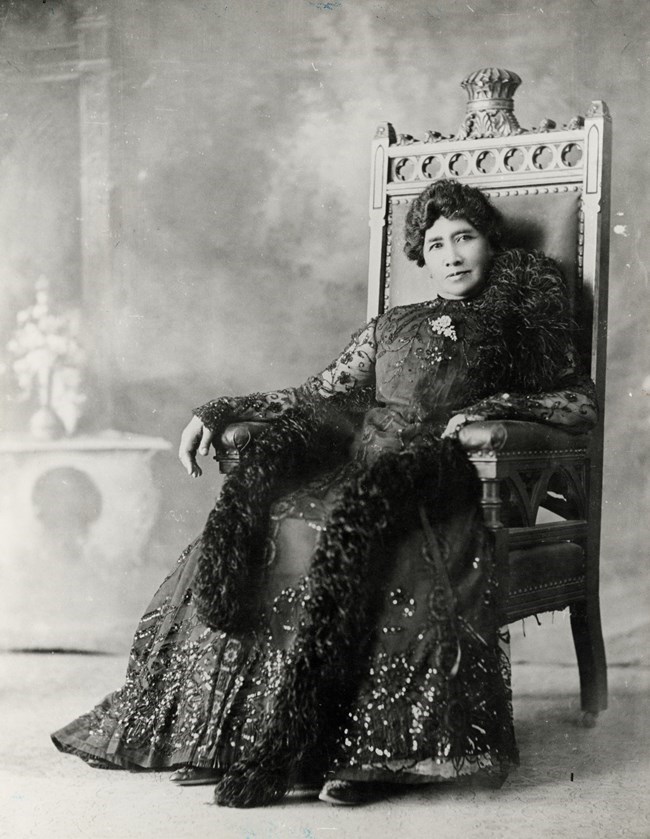Part of a series of articles titled Women's History in the Pacific West - Pacific Islands Collection.
Previous: Katherine Ah Lan Lowe
Next: Geraldine Kenui Bell
Article

Hawai'i State Archives(PP-98-12-012)
Queen Lili‘uokalani was the last sovereign of Hawai‘i. Many continue to admire Lili‘uokalani for her resolute and peaceful resistance to the US businessmen who ended her reign and to the United States’ annexation of Hawai‘i during the 1890s.1 The 1892 Highways Act was one example of her diligent labor as queen for the welfare of her people. It defined and protected Hawaiian trails and endures as a tool that the state of Hawai‘i uses to claim public trails and maintain rights of access despite private land ownership, including much of the Ala Kahakai National Historic Trail.2
Lili‘uokalani was born on September 2, 1838 to High Chief and Chiefess Caesar Kapa‘akea and Analea Keohokālole, and named Lydia Lili‘u Loloku Walania Wewehi Kamaka‘eha.3 Her mother was an advisor to Kamehameha III, the king who in 1840 promulgated the first written constitution to the Hawaiian people. Lili‘uokalani’s claim to the throne was established when she became the child of hānai parents (a traditional Native Hawaiian practice of adoption to strengthen alliances among chiefs), High Chief and Chiefess Pāki and Konia. Among the multiple schools she attended were those designated for children in the royal line.4 She was a talented haku mele (music composer), saying “to compose was as natural to me as to breathe.”5 In 1866, at the behest of Kamehameha V, she composed a national anthem for Hawai‘i, “He Mele Lāhui Hawaiʻi,” that was used for the next twenty years. In 1862, she married John Owen Dominis, a white American whom she knew from her school days.6 She adopted three children between 1878 and 1910, two through the Hawaiian custom of hānai.7
Her brother, David Kalākaua, was elected king in 1874. Kalākaua made his sister the heir apparent and gave her the name Lili‘uokalani. During her time as princess, she traveled the world, met with foreign dignitaries and made trips around Hawai‘i to keep close contact with her people. In 1886, she organized the Lili‘uokalani Educational Society to provide schooling for impoverished Hawaiian girls.8 During Kalākaua’s reign, American landowners staged a coup and plotted against the monarchy, forcing the king to sign the “Bayonet Constitution” in 1887 that gave them more power.
Lili‘uokalani became queen in 1891 and worked to restore power to the Hawaiian monarchy and her people.9 In 1892, along with the Legislature of the Kingdom of Hawai‘i she passed an act to protect public lands from privatization. This Highways Act declared existing trails, roads, and bridges, as well as future government-built ones to be public highways. In 1893, after Lili‘uokalani attempted to push forward a new constitution, American landowners staged a coup. Between 1893 and 1898, Lili‘uokalani and her fellow Kānaka Maoli (Native Hawaiians) mobilized against US annexation of Hawai‘i through political parties, in the press, and with petitions. They also sent delegations to Washington, DC. Lili‘uokalani published Hawaii’s Story by Hawaii’s Queen to lay out her arguments against annexation and to counter racist representations of herself and Kānaka Maoli in the US. When some of her supporters sought to restore the monarchy through an armed revolt in 1895, the provisional government imprisoned Lili‘uokalani and forced her to surrender the throne. Still, Hawaiian newspapers published songs she managed to smuggle from house arrest. She and other Kānaka Maoli used song to resist cultural and political imperialism.10 Her song “Aloha ‘Oe,” originally written in 1878 but transcribed while she was under house arrest, became a popular national song.11
Lili‘uokalani continued to advocate for Hawaiian sovereignty and cultural retention for the rest of her life. Despite Native Hawaiians’ extensive resistance, the US annexed Hawai‘i in 1898. In 1909 she established a trust for Hawaiian children in need, and left her estate to help Hawai‘i’s children.12 She died on November 11, 1917, and was given a royal burial.13 Her life remains an inspiration to Kānaka Maoli and many others. The Ala Kahakai National Historic Trail, established in 2000, preserves a network of ancient, historic and modern trails, only possible due to the foresight of Lili‘uokalani’s Highways Act of 1892 , and is just one of the many ways that her legacy is visible in the Hawaiian landscape.
Part of a series of articles titled Women's History in the Pacific West - Pacific Islands Collection.
Previous: Katherine Ah Lan Lowe
Next: Geraldine Kenui Bell
Last updated: August 21, 2025